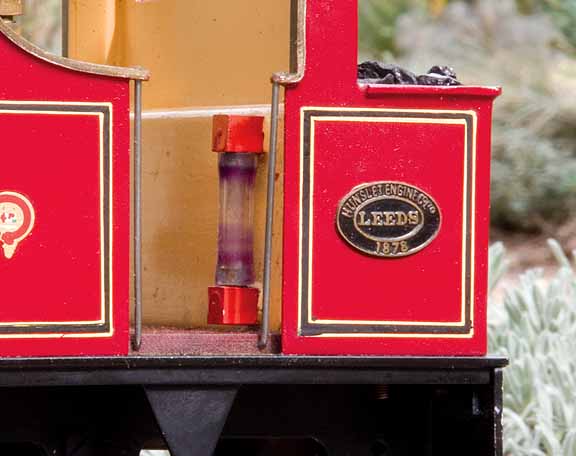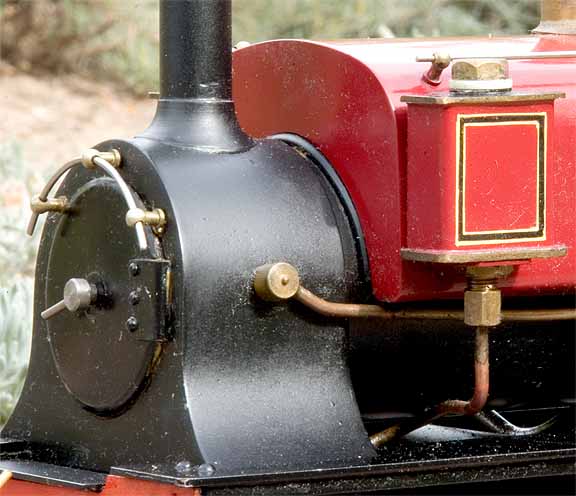
Back to Loco of the Month homepage
Back to Sidestreet Bannerworks
.
October 2007
Hugh Saunders’ Beddgelert
by Marc Horovitz

Not a great deal appears to be commonly known about the prototype of this large saddle-tanker. It was built by Hunslet in 1878 for the North Wales Narrow Gauge Railways as an outside-frame 0-6-4T, an unusual wheel arrangement. It was the largest of the locomotives built for this line.
There are only four photos of the engine known to exist. By rights, it should never even have been built because the company obtained its motive power by a peculiar leasing arrangement, and the provider was obliged by the contract to buy only locomotives of the Fairlie type, which all the rest of the NWNGR fleet were. Beddgelert was scrapped in 1905, and that can be interpreted in two entirely different ways, depending on which book you read. Either it was the drivers' favorite, and consequently worked into an early grave or it was unpopular and they were glad to see the back of it. Take your pick! (--Thanks to Tim Lockley for this additional information.)
The name Beddgelert is interesting. It means "Grave of Gelert." The story is a little long but, briefly, Gelert is the name of a much-loved dog that was unjustly killed by its master, a Welsh prince, who believed that the dog had killed and eaten his infant child. When the child was found safe and it was discovered that Gelert had, in fact, killed a wolf that had tried to eat the child, the prince was filled with remorse and the legend was born.
The model
This engine, like virtually all of Hugh Saunders' work, is a fine, well-made model. It has a relatively high amount of detail and is nicely finished and lined out. It has two, double acting, D-valve cylinders that are reversed by slip eccentrics. Valves are inside the frames. The drive axles are unsprung, but the trailing bogie, which bears some of the engine's weight, is sprung and the wheels are equalized within a secondary frame, so all four feet are always on the rails. The rods are beautifully made, being machined from the solid as opposed to stamped from sheet or plate.
Cab fittings include the throttle, blower, pressure gauge, whistle valve, and water glass. The whistle itself lives under the right-hand footplate. The engine's safety valve is under an ornate dome, with dummy safeties outside it.
A working saddle tank sits astride the boiler and there is a hand pump in the cab, with a removable handle, to keep the boiler level up. The tank has a balance pipe to equalize the water level in both sides. The boiler has a proper (dry) firebox and a single large flue. There are cross tubes in both the firebox and the flue to increase the heating area and water capacity. The burner is Hugh Saunders' standard box-type alcohol burner, perforated with air holes. It must be lit through the fire door in the cab. Fuel is stored in the rear bunker, under the coal load in a chicken-feed tank.
This locomotive has some unusual features. There are a pair of displacement lubricators, one on either side disguised as sand boxes. Each feeds one cylinder. The fuel tank has the welcome amenity of a sight glass in the cab. The filler cap for the fuel tank is disguised as a bucket. You stick a screwdriver into the bucket to engage the slot at the bottom. The fuel-control valve is under a liftoff water can. To gain access to the burner, the rear bogie slips right off. A spring helps to hold it in place while the engine is in operation.
The run
This locomotive had not been run in some time, so I gave it a good looking over while oiling it all round. All appeared well except that the eccentrics were gummed up from old oil and didn't want to slip in their straps the way they should. I applied some fresh oil and worked it in, which loosened the eccentrics quite a lot.
With the engine fueled and watered and both the lubricators filled, I set it on the track and popped the fan in the stack. I lit the fire through the fire door and sat back. Steam came up fairly quickly. At 20 psi I opened the blower and removed the fan. The safety let go at 40 psi and I opened the throttle, The engine took a fair amount of coaxing to get it going, showing little inclination to run at the outset. However, as the cylinders warmed and the condensate finally cleared, Beddgelert finally came to life. I tried the whistle, which was more or less useless, as these little whistles tend to be. It worked best at very low pressure.
The engine is a fine runner with an audible exhaust beat. It's definitely a driver's engine, and attention must be paid to the state of the boiler at all times. I found out early on that it is best to add water little and often. I had stopped the engine to pump up the boiler, but added too much water. When the pressure drops below about 20 psi, the fire goes out. After losing the fire a couple of times I started giving the pump a few strokes every other lap. That did the trick. The level stayed up, as did the pressure.
Beddgelert is easy to control, especially with the roof off, and will run at a nice, sedate speed, even running light. Its small drivers help keep the speed down.
Reversing was a little difficult, as the eccentrics hadn't loosened as much as they needed to -- or at least one of them hadn't. I backed the loco to reset the valves, but only one side reversed. Needless to say, that didn't work. But with further encouragement I got both sides to finally reverse, and the engine ran just as well backwards.
Like others of Hugh Saunders' engines, this one is a fine runner. It can be kept in steam indefinitely, with the addition of fuel and water to their respective tanks. It's a pleasure to operate.
|
|
|
| Builder | Hugh Saunders |
| Date built | Mid 1980s (?) |
| Gauge | 0 (32mm) |
| Scale | 16mm |
| Boiler | Single flue with firebox -- water tubes in flue and firebox |
| Fittings | Safety valve, throttle, blower, whistle, check valve, water glass, pressure gauge, hand pump |
| Fuel | Alcohol |
| Blow-off pressure | 40 psi |
| Cylinders | Two, double-acting D-valve |
| Reversing gear | Slip eccentrics |
| Lubricator | Displacement (two) |
| Weight | 8 lbs., 8 oz. |
| Dimensions | Length, 13"; width, 4"; height, 5-3/16" |










Back to Loco of the Month home page
Back to Sidestreet Bannerworks home page
This page and its contents
Copyright Sidestreet Bannerworks, 2007
.